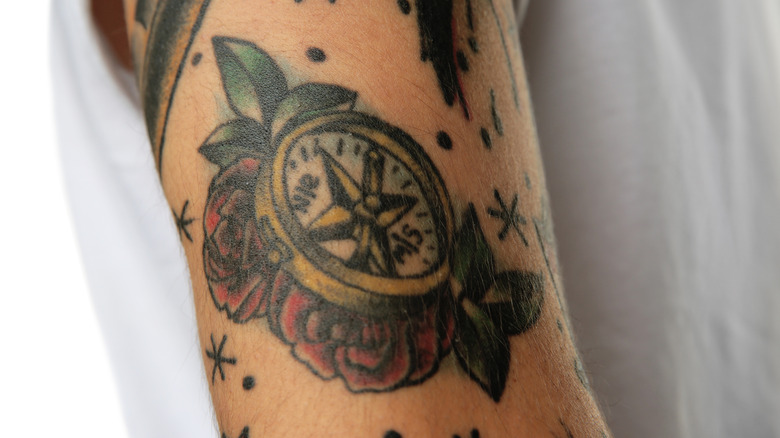The Real Origin Of Compass Tattoos
There are many ways to symbolize feelings of wanderlust in a tattoo, but nothing beats a traditional compass. Variations of the design have become extremely popular over the past decade, but you may not know how far back this motif goes.
For some, a compass tattoo is a symbol of adventure (via Next Luxury), or a way to remind yourself where your roots lie. For others, it can represent feelings of ingenuity or reliability (via TattMag). The tattoo can also be fairly literal in showcasing a person's strong moral compass or their strength in being grounded in the here and now.
This is obviously a tattoo that has become timeless, but why? Where exactly did the compass tattoo originate from, and how did it become such a recognizable design within the body art world? Read on to find out the real origins of the compass tattoo, and how you can integrate it into your next piece of ink.
Compass tattoos date as far back as the 16th century
According to TatRing, the compass tattoo can be dated back as far as the 16th century where European sailors would decorate their bodies with tribal "souvenirs" from their travels to the Pacific islands. Sailors would tattoo each other with the materials they had, which may have included gunpowder instead of ink.
Most tattoos adorning men of the sea were to mark their travels, reminders of places they'd visited, and as talismans to protect themselves from bad luck. These tattoos also "became a mark of belonging" (via Authority Tattoo), and young sailors would often be inked as part of an initiation ceremony. They were also used as a way to identify the unfortunate souls that fell overboard.
As for the compass itself, TattMag dates the origin of the navigational tool back to China during the beginnings of the Han Dynasty (via TimeMaps) in 200 BC. The instrument changed considerably over time, eventually becoming the portable version that'll be familiar to many.
This version flourished in Europe within the Renaissance period, where the compass rose, a star-like figure on a compass that displays the cardinal and inter-cardinal directions, first made an appearance.
They can signify protection and guidance, as well as your life journey
For sailors, compass tattoos were primarily given as a mark of "protection and guidance" while traveling the seas, according to Next Luxury. They also signified where they came from, providing them a connection to their home.
This meaning has survived for over 500 years, and is now often chosen as a tattoo design for luck, protection, a sense of adventure, and as a way to signify a person's life journey. When the compass rose is used on its own without the rest of the tool, it can symbolize love (via Next Luxury).
Some designs utilize other navigational items like maps and clocks. Maps are an obvious nod to the beauty of exploring the world, while a clock can signify that there's only so much time you can travel in one lifetime.
Other designs may include the Vegyisir, the Nordic Compass otherwise known as the Wayfinder. The Vegyisir is often used as a symbol of protection as well as one of luck for travelers (via TattMag). Celtic knots are often incorporated into compass designs as a way of displaying pride in ancestry, according to Custom Tattoo Design.


